The most unpleasant symptoms, in the form of itching and rashes, can cause subcutaneous parasites in people of all ages. Any invasiveness brings a lot of health problems due to complications. Worms with an incubation period of several months are especially dangerous.
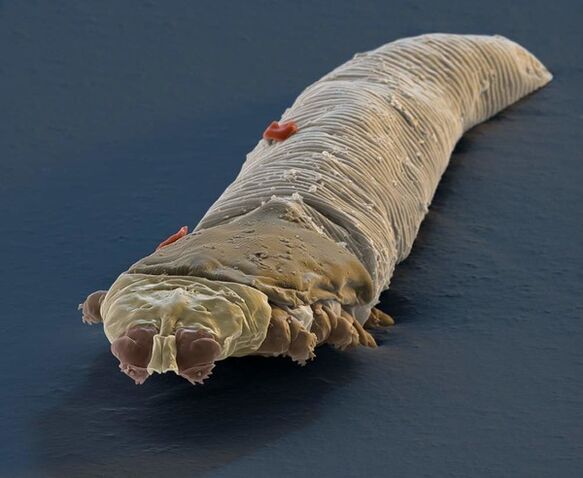
Types of parasites that live under the skin
Subcutaneous worms can enter the human body: tactile contact with an infected person; from blood-sucking insects that carry parasitic larvae from animals.
The main feature of such an invasion is the difficulty in recognizing the pathology, since at first the infection can be disguised as other somatic diseases.
When caught under the thickness of the skin, the parasites over time can migrate to any internal organs and cause their dysfunction. The worms feed on blood and use it to incubate the larvae.
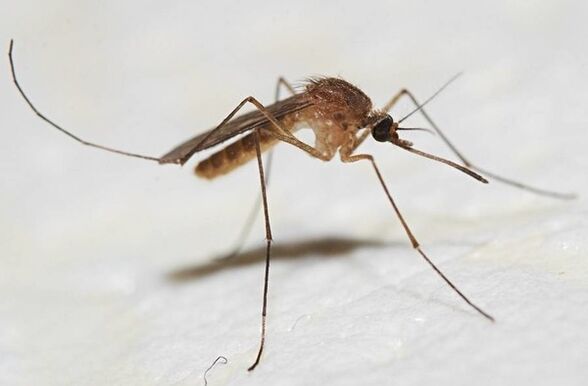
The main signs of the presence of this parasite in the body are severe weakness, decreased performance, frequent urge to scratch the skin. When these signs appear, it is advisable to see a specialist: a therapist, a dermatologist, an allergist, an infectious disease specialist. The joint work of doctors and the diagnostic methods they use in their work help to promptly recognize the presence of subcutaneous invasion in the body.
Among the diagnostic methods, studies of stool, blood, scalp and epidermal scraping are required.
The most common helminthic infections occur in countries with very warm climates - Central Asia, Africa, South America. Therefore, returning from traveling across continents, you need to pay special attention to your health.
Important! It is strictly forbidden to self-medicate with medical and folk remedies - this can aggravate the situation and poison the body. Do not delay the visit to the doctor and strictly follow the prescribed course of medication.
There are many types of worms that live in the skin. The invasive species listed below are the main ones.
Heartworm disease
Subcutaneous helminths of this species are represented by filamentous nematodes, common in tropical states. This type of parasite can live in the skin for several years continuously, after adapting, they will move around the body and look for other habitats.
The sign of the disease when it first appears is a red skin rash in the form of urticaria and dots, accompanied by itching. Then the temperature is added.
Severe signs of filariasis include eczema, ulcers and warts, subcutaneous nodules, severe headache, drowsiness, subcutaneous nodules, and increased fever.
Often the parasite can be found on examination by an ophthalmologist, as it prefers to live in the mucous membranes of the eye.
Important! If not promptly seen by a doctor, filariasis contributes to the appearance of eye diseases and leads to complete loss of vision.
schistosomiasis
Parasites of this species live in warm freshwater rivers and lakes in hot climates. Infection can occur when bathing or drinking raw water.
The parasite also affects the skin and urinary system. Toxic substances that enter the blood cause a strong intoxication of the body, and this leads to various disorders of the work of many organs and systems.

Signs of a parasitic infection are: an inflammatory skin rash and flushing on the skin, itching and discomfort, night sweats, enlarged liver, dysfunction of the kidney system, and a sudden rise in temperature. suddenly.
Schistosomiasis, which occurs with damage to the genitourinary system, blocks the in and out tubes of the bladder.
Important! In order not to get infected with this worm, you should not swim in standing waters of the tropics and drink raw water from unfamiliar natural sources.
Dracunculiasis
Disease caused by rishta - roundworm - parasitic, up to 80 cm long, worm infestation is endemic to countries with tropical and central Asian climates, can be caused by the use of raw water or by contact with cats and dogscoincide.
The incubation period from infection with fluke eggs and movement in the body is 1. 5 months. Parasites grow and develop year round.

Dracunculiasis mainly affects the skin of the lower extremities. The parasite can twist and burst, forming a long blister on the skin, followed by a few centimeters of bubbles. As soon as the bubble comes into contact with water, it bursts instantly, releasing the larvae, causing severe itching inside.
Important! If therapy and fight against this parasite are not carried out, then the person will begin to develop sepsis, lymphadenitis or joint immobilization.
Scabies
Mites up to 0. 4 mm in size are the culprits that develop scabies. The parasite can be acquired by contact with an infected person's body or their objects, if the person has a severely weakened immune system. Infection occurs when hygiene rules are not observed.
Small parasites on the skin are introduced first into the epidermis, then into the deep layer and are capable of spreading toxins throughout the body. Parasites gnaw the passageways in which they lay their eggs.
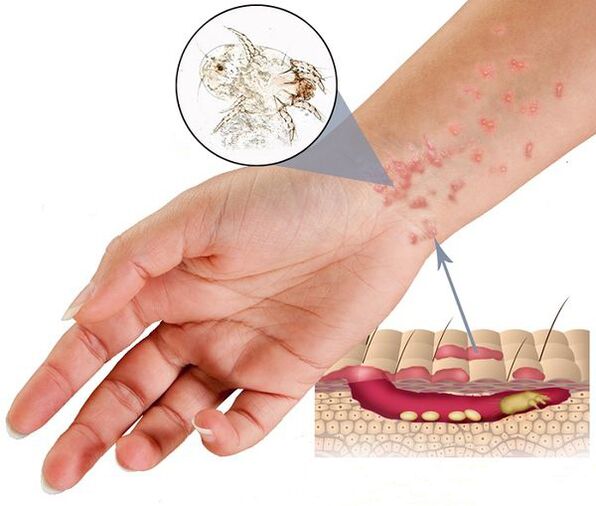
Clinical symptoms of the pathology appear in the form of a red rash, small blisters, and peeling of the skin on: hands, thighs, elbows, knees, and hair. If you treat the places of the rash with an iodine solution, then you can see the ticks.
Due to the active development and reproduction of parasites, a person is tormented by unbearable itching, the itching is more intense at night, the desire to scratch the skin, as well as after contact with water.
Complications of scabies include developing boils, eczema, dermatitis, and vesicular lesions on the skin.
Important! In order not to get scabies, you need to observe the rules of hygiene, avoid contact with people with scabies.
Demodecosis
This disease, caused by a microscopic tick, is seasonal in nature and is more common in the fall. The formation of excess fat on the skin in summer and the negative effects of ultraviolet rays depress local immunity, which contributes to the spread of this tick.
Parasites can be transmitted through tactile contact with an infected person, as well as the use of their personal belongings and care items.
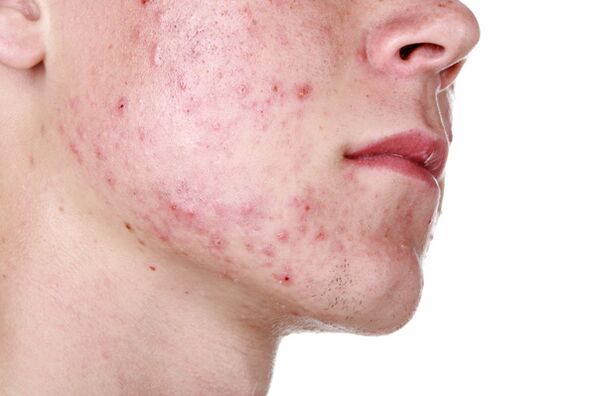
Pathology, according to clinical signs, is very similar to acne, occupying more and more territory. Pink and red papules appear more on the face and back, leaving rough scars after healing. A person may experience eyelid inflammation, vasodilation, and flaking of the eyebrows.
Important! Demodectic mange evolved over the years. To correctly diagnose a person, a scrape is taken from the skin. Healing can take up to 3 months.
Dirofilariasis
Invasive is considered a dangerous parasitic disease, caused by the worm dirofilaria, which when grown up to 30 cm long, this parasite affects areas under the skin, as well as eye tissue and can cause vision losscomplete force.
The incubation period for the development of filariasis is several years. A person can become infected by mosquito bites, which carry parasitic eggs from sick dogs and cats.
A seal grows on the skin, accompanied by pain, unbearable itching and congestion. The seal can grow to be the size of an average egg, in which the coiled worm lives.
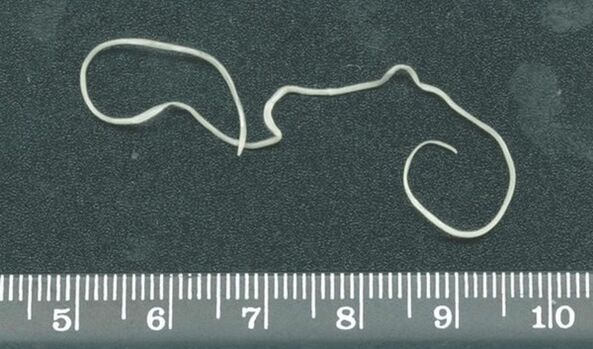
Basically, the parasites live in the skin but sometimes they can get into the eye leading to impaired vision and loss of vision.
In order not to get infected with this worm, you need to fight mosquitoes with all possible methods and use repellents in your daily life.
How to get rid of parasites under the skin?
The fight against worms that develop under the skin is based on the use of superficial and medicinal methods, as well as surgical operations.
Antiparasitic therapy for each type of helminth can be presented in the form of a table:
| The type of worms | The methods applied |
|---|---|
| Heartworm disease | Dewormer for the treatment of filariasis. In severe cases, surgery. |
| schistosomiasis | Antimony and surgical techniques are used. At the same time, it is necessary to restore the affected organs. |
| Dracunculiasis | Neat deworming surgery. |
| Scabies | Topical remedy: salicylate ointment and sulfuric soap; soapy water suspension; hydrochloric acid solution for 1 week. Immunological preparations. Thoroughly disinfect the patient's clothing and household items. Sometimes antibiotics are used. |
| Demodecosis | External agents are used: camphor tincture, as well as thorough cosmetic care (cleansing, masking, peeling), the use of hyaluronic acid, alginate. Immunostimulating drugs, vitamin complexes, anti-inflammatory drugs are used. Ensure simultaneous treatment of gastrointestinal and metabolic disorders. A healthy diet and physical therapy are essential. |
| Dirofilariasis | Surgical treatment. The eyeball may need to be removed. |
In most cases, you can get rid of the worms under the skin with surgery and an intensive course of chemotherapy.
Shy treatment
Topical methods are used against helminths living in the epidermis (eg, scabies and filariasis).
Scabies medication is applied externally to the affected area. These drugs are applied all over the body at night. The course lasts 2 weeks. People who have been in contact with an infected person should perform the same procedures.
With antiseptics, suspensions, ointments, solutions, lubricating gels, scrubs, cryotherapy is used to reduce mucus secretion, remove food and reduce the negative effects of parasites. parasites.
With other helminths, external manifestations are eliminated with the help of steroid ointments and antibiotics.
All ointments specially selected by doctors reduce inflammation, eliminate the locomotor activity of parasites and destroy them.
Topical procedures must be applied sparingly, avoiding damage to the skin, so as not to disturb the acid-base balance and to exclude the attachment of pathogenic bacteria to the pathology.
Important! When starting the treatment in very hot temperatures, it is necessary to wash and warm the pillow under the bright sunlight.
Drugs
For each type of helminth, a separate medication will be prescribed by the doctor in accordance with the stage of the disease.
Some drugs completely kill the parasites, others immobilize them and prevent reproduction.
When the helminth dies, a person may show signs of intoxication - headache, nausea, vomiting, so drugs are selected carefully. The introduction of sorbent is allowed.
The main diseases are necessarily treated with pathologies from other organs. Symptomatic therapy is used.
Surgical method
The intervention of the surgeon is necessary to remove the parasite through the incision.
The surgery took place as usual under local anesthesia. Surgeons need to be technically skilled and skilled so that when removing the worms completely, not divided into parts.
Methods of rehabilitation after surgery include treatment with antibacterial, analgesic, anti-inflammatory drugs, as well as antiparasitic drugs.

Prevention of helminth infections
With caution, you can completely prevent worms under the skin from entering the body.
Necessarily necessary:
- annual medical examination;
- consult a doctor for any kind of illness;
- wash hands thoroughly after going to public places and having tactile contact with strangers and stray animals;
- boil raw water, and do not drink water from natural sources;
- do not swim in standing water, especially in hot countries;
- to combat blood-sucking insects using repellents and protective devices;
- Perform regular and general house cleaning, maintaining order.
When traveling to epidemiologically dangerous countries, it is important to observe safety measures and be sure to learn all the information on how to protect yourself during your trip.
It is necessary to improve immunity by living a healthy lifestyle, eating in moderation, working hard and taking multivitamins several times a year.
Fighting parasites under the skin takes patience and effort. If you follow all the doctor's prescriptions, the patient will fully recover.





























